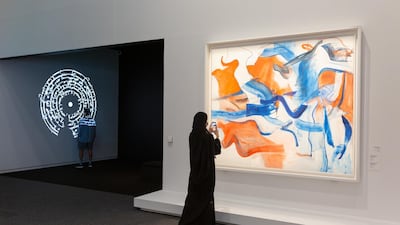The path to abstraction in art, particularly western art, was not straight and narrow. Instead, it intersected with other roads from the East, crossing into calligraphy, hieroglyphs and symbols.
These influences are apparent in Louvre Abu Dhabi’s exhibition, Abstraction and Calligraphy – Towards a Universal Language, which opened in February and is on view until June 12.
More than 80 artworks, many shown in the region for the first time, are included in the show, with creations by Wassily Kandinsky, Joan Miro, Jean Dubuffet, Willem de Kooning, Jackson Pollock and Cy Twombly, as well as Dia Azzawi, Mona Hatoum and Shakir Hassan Al Said.
Organised in four themed sections, the exhibition charts the development of abstraction in visual art since the early 20th century, examining how artists looked to various cultures and writing systems to expand their ideas.
To underline this narrative, Louvre Abu Dhabi included historical objects from ancient Egypt and the Islamic world, inserting them between the artworks for comparison. These include a stone slab with Egyptian inscription and a page from the Blue Quran, which dates back to 900 AD and contains Kufic calligraphy written in gold on blue-dyed parchment.
The influence of these logos and alphabetical forms can be found in Joaquin Torres-Garcia's 1937 Universal Composition, a pictogram-filled painting that resembles the inscriptions of ancient cultures. The same goes for Paul Klee's Oriental Bliss from 1938, a colourful work that demonstrates the artist's fascination with Egyptian hieroglyphs and Chinese and Arabic alphabets. Kandinsky's Trente continues this style, though his elements are more sinuous and complex, as though trying to depict a message or story.
Artists such as Andre Masson charted his own approach to abstraction, borrowing from literary movements such as surrealism to consider how the unconscious can be visualised on the canvas. This resulted in paintings that express some kind of inner vision, with organic and intuitive lines. Miro takes this further with his poem-drawings, such as Femme, oiseau [Woman, Birds], which is part of the exhibition and shows spontaneity through intense, expressive lines.
A number of works by Dubuffet, on loan from Centre Pompidou, exemplify a spontaneous approach to art that is almost primitive in its visual language. The artist rejected scholarly interpretation of artworks, instead focusing on authentic, "raw" art.

The influence of calligraphy and writing systems reached Arab artists as well, as seen in the works of Al Said, Azzawi and Sliman Mansour, among others. Looking towards the Arabic script, artists sought to break down the letters into graphic elements and forms.
One highlight is Mansour's Graffiti – a textured work made of mud, wood and other materials that feature geometric etchings and bears earthy hues along with a spray-painted scrawl. From afar, it resembles a carved out stone or slab.
Artists such as Hatoum and Ghada Amer explore the Arabic alphabet in their own ways, wielding them into sculptural works. Hatoum's Found (Wire Drawings) are like scrawls of ancient text, but are actually scrap metal from Lebanon's civil war, while Amer's The Words I Love Most conjoin words into a cast bronze globe that spells out Arabic words of humanity.
As part of the programming for the exhibition, Louvre Abu Dhabi is presenting a two-day masterclass on Saturdays, June 12 and 19 on calligraphy and abstraction with renowned calligrapher Mohammed Mandi, who is also the lead calligrapher and artist at the Abu Dhabi Cultural Foundation's Bait Al Khatt Centre, and Juma Alhaj, an Emirati abstract artist. In addition, online demonstration and talk by Mandi is available on the Louvre Abu Dhabi website.
The museum has also created a virtual tour of the exhibition on its website, as well as recordings of a discussion with Didier Ottinger, assistant director of the Centre Pompidou and curator of the show, and Berklee Abu Dhabi's pop-up performance titled Unlock the Language of Music.



![Wassily Kandinsky, 'Trente [Thirty]' (1937), oil on canvas. Centre Pompidou, MNAM-CCI, Dist. RMN-Grand Palais / Philippe Migeat](https://www.thenationalnews.com/resizer/v2/DV7VXYBIVN6APEEVFSIN4DSDIY.jpg?smart=true&auth=72cebecdca664bb2a92b03e4d4f606bc9337d13fbdaefa070d33cdc716e8e3b0&width=400&height=225)




